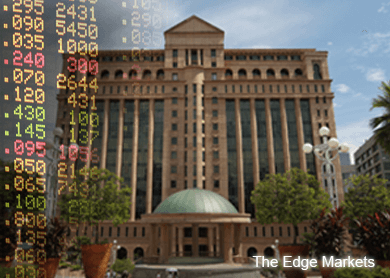
KUALA LUMPUR: Malaysian stocks snapped a five-day losing streak yesterday on the back of a better-than-expected gross domestic product (GDP) growth for the second quarter, with the FBM KLCI closing up 11.69 points.
The benchmark index ended 0.73% higher at 1,621.62 points after trading as low as 1,605.46 points in the early part of the session. Market breadth turned positive, with 714 gainers against 217 decliners, while 252 counters were unchanged. The index has lost 115.63 points or 6.7% since Aug 5, when it closed at 1,609.93 on concerns over the direction of the ringgit following Bank Negara Malaysia’s (BNM) announcement of a drop in international reserves.
PublicInvest Research head Ching Weng Jin said the FBM KLCI’s rebound was supported by local buying activity, as investors dabbled in some bargain-hunting following the recent weakness of the market.
“The index can sustain its gains if it holds at the 1,600 level and no other negative surprises come up in the near term,” he told digitaledge DAILY yesterday.
He noted that the rise in the FBM KLCI was in line with gains made by regional markets.
Valuecap Sdn Bhd group chief executive officer Sharifatu Laila Syed Ali expects the market to stabilise, noting that the FBM KLCI has come off its peak this year by about 14%, with futures trading at a discount.
“We do see value emerging selectively, so bottom-fishing will take on a very selective and differentiating approach. Stocks trading at steep discounts to their revalued net asset values appear the favourites.
“Investing in value requires patience and therefore requires longer-term positioning. We are not looking at quick trades as these tend to be short-term in nature and risky,” Sharifatu said.
The ringgit yesterday strengthened slightly to trade at 4.0107 against the US dollar, compared with its close of 4.0275 on Wednesday.
“For the ringgit, its major weakening period has ended, and right now it’s tracking the yuan. We expect the ringgit to stay around its current levels in the near term and to return to the 3.7, 3.8 levels within the medium to longer term,” said PublicInvest’s Ching.
Kenanga Investment Bank economist Wan Suhaimi Saidi said the pace of depreciation of the local currency in the past weeks has been quicker than in the first half of the year, noting that the ringgit has depreciated 13.4% year to date, with close to half of the fall (6.3%) occurring in the past month alone.
“Broadly speaking, the longer-term causes of the ringgit weakness can be put down to persistently weak global commodity prices and a widening monetary policy gap between the United States and the rest of the word, resulting in what has turned out to be an unrelenting sell-off in emerging market currencies for safe haven alternatives,” said Wan Suhaimi.
Affin Hwang Capital Research said there is a strong possibility of the People’s Bank of China devaluing the yuan further, expecting more downward fluctuation in the daily yuan reference rate, especially as the US Federal Open Market Committee’s September meeting approaches.It is anticipated that the first interest rate hike by the US will be implemented after the September meeting, which the research house said could add more pressure to currencies in the Asean region, given the fall in the yuan.
Affin Hwang Capital expects the ringgit to trade around 4 against the US dollar until the end of third quarter of 2015 due to the strength of the greenback and vulnerability of the yuan, while current account surpluses and healthy international reserves will support the ringgit to trade towards 3.9 to 3.95 by end-2015.

This article first appeared in digitaledge Daily, on August 14, 2015.